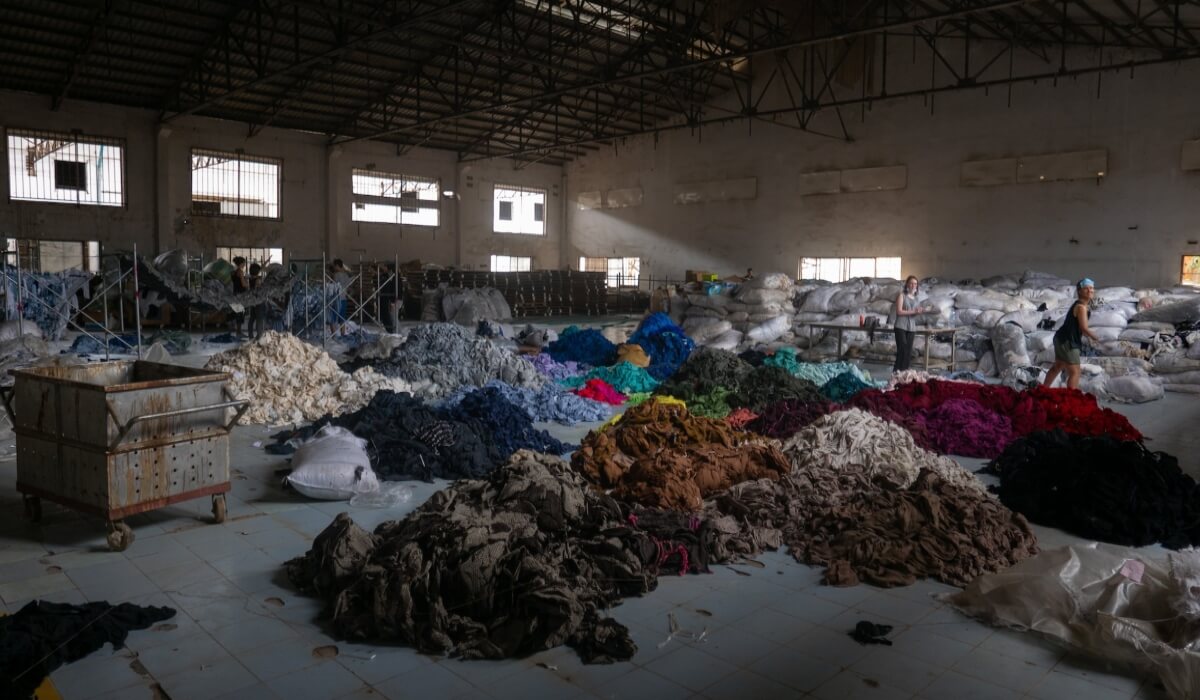Standards and procedures in garment quality assurance are essential for maintaining consistency, customer satisfaction, and brand reputation. Quality assurance ensures that garments meet specified requirements and adhere to industry standards throughout the production process.
Featured Photo by Francois Le Nguyen on Unsplash
To achieve this, a comprehensive set of guidelines, protocols, and inspections should be followed strictly. This includes meticulous inspection of fabrics, trims, stitching, fittings, and overall construction. Standards must also cover issues related to color fastness, shrinkage control, durability of prints or embellishments, as well as accurate sizing. Procedures may involve conducting initial sample assessments, conducting regular checks during production stages, and carrying out final inspections before shipment.
Additionally, clear communication channels with suppliers and manufacturers should be established to resolve any issues promptly and transparently. Adhering to strict quality control measures ultimately contributes to improved customer satisfaction rates while leveraging the brand’s competitiveness within the fashion industry.
Standards and Procedures
Quality assurance encompasses a set of standards and procedures designed to monitor and maintain consistent levels of quality throughout the garment production process. In the rapidly evolving and competitive world of garment manufacturing, ensuring high product quality and customer satisfaction has become paramount. This is where quality assurance comes into play.
This article explores the importance of quality assurance in the garments industry and delves into the key elements of a robust quality assurance program. Additionally, it discusses the challenges faced by garment manufacturers in maintaining quality, highlights best practices and explores the role of technology in enhancing quality assurance. Lastly, it looks at the future trends and innovations shaping the quality assurance landscape for the garments industry.
Introduction to Quality Assurance in the Garments Industry
1.1 The Significance of Quality Assurance in Garment Manufacturing
In the competitive world of garment manufacturing, quality assurance plays a vital role. It ensures that the garments produced meet the desired standards of quality, durability, and aesthetics. Quality assurance helps build trust between manufacturers, retailers, and consumers, making it a crucial aspect of the industry.
1.2 Understanding the Role of Quality Assurance in the Garments Industry
Quality assurance in the garments industry involves a systematic approach to monitor and control every stage of the manufacturing process. From raw material selection to production and post-production, quality assurance ensures that the garments meet the required specifications and customer expectations. It helps identify and rectify any potential issues that may affect the final product, guaranteeing customer satisfaction.

2024 HAIDEN DEEGAN T-SHIRT DEEGAN APPAREL – PICK SIZE & COLOR
Importance of Standards and Procedures in Garment Manufacturing
2.1 Why Standards and Procedures are Essential in Garment Manufacturing
Standards and procedures in garment manufacturing provide a consistent framework for achieving quality and uniformity in products. They establish guidelines and benchmarks throughout the production process, enabling manufacturers to maintain a high level of product quality. Standards and procedures also facilitate effective communication between different stakeholders, ensuring everyone is on the same page and working towards the same goals.
2.2 Impact of Standards and Procedures on Product Quality and Customer Satisfaction
Implementing standards and procedures in garment manufacturing directly impacts product quality and, subsequently, customer satisfaction. By adhering to established standards, manufacturers can minimize defects, reduce variation, and meet the expected product specifications consistently. This, in turn, enhances customer satisfaction, builds brand reputation, and establishes a loyal customer base, driving long-term success.
Key Elements of a Quality Assurance Program in the Garments Industry
3.1 Defining Quality Standards for Garment Production
Defining quality standards involves setting clear and measurable criteria for garment production. It includes specifications for fabric quality, color consistency, stitching techniques, fitting, and finishing. By establishing these standards, manufacturers can ensure that each garment leaving the production line meets the desired quality level.
3.2 Establishing Standard Operating Procedures (SOPs) for Quality Assurance
Standard operating procedures outline step-by-step guidelines for quality assurance activities. They cover aspects such as quality inspections, product testing, defect identification, and corrective actions. SOPs help maintain consistency in quality assurance processes, empower employees with clear instructions, and enable effective monitoring and control.
3.3 Training and Skill Development for Quality Assurance Personnel
Quality assurance personnel play a crucial role in upholding quality standards. Training programs should focus on enhancing their understanding of quality requirements, teaching them inspection and testing techniques, and developing their problem-solving skills. Investing in training and skill development ensures that quality assurance personnel are equipped to identify and address potential quality issues efficiently.
Also Read: Garments Industry: Quality Control Standards and Procedures
Implementing Quality Standards and Procedures in the Garments Industry
4.1 Steps to Implement and Integrate Quality Standards
Implementing quality standards requires a systematic approach. It involves conducting a thorough evaluation of existing processes, identifying gaps or areas for improvement, and implementing necessary changes. Integration of quality standards should be done at each stage of the manufacturing process, ensuring quality control is maintained from raw materials to finished garments.
4.2 Importance of Documentation and Record-Keeping in Quality Assurance
Documentation and record-keeping are vital components of quality assurance. They provide a historical trace of activities, including inspections, tests, and corrective actions taken. Good documentation practices enable manufacturers to track and analyze data, identify trends, and make informed decisions to further enhance quality standards and procedures.
4.3 Auditing and Reviewing Quality Assurance Processes
Regular auditing and reviewing of quality assurance processes are essential to ensure ongoing compliance with standards and procedures. Audits help identify any deviations or non-conformities, allowing manufacturers to take corrective actions promptly. Reviewing the effectiveness of quality assurance processes enables continuous improvement, fostering a culture of excellence and quality consciousness in the garments industry.
Challenges and Best Practices in Quality Assurance for Garment Manufacturers
5.1 Common Challenges Faced in Maintaining Quality Assurance
Quality assurance in the garments industry is no easy task. Manufacturers are often faced with a myriad of challenges when it comes to maintaining consistent quality standards. One common challenge is the variability in raw materials. Garment manufacturers rely on different suppliers for fabrics, trims, and accessories, which can lead to inconsistencies in quality. Additionally, the fast-paced nature of the industry can make it difficult to ensure that every garment meets the required standards. Tight production schedules and high demand can sometimes compromise quality control processes.
5.2 Best Practices for Overcoming Quality Assurance Challenges
To overcome these challenges, garment manufacturers can adopt several best practices. First and foremost, establishing strong relationships with reliable suppliers is crucial. Working closely with suppliers who consistently provide high-quality materials can significantly reduce inconsistencies. Another effective practice is implementing robust quality control measures at every stage of production. Regular inspections, testing, and audits can help identify and rectify any potential issues before the final product is delivered. It’s also essential to invest in employee training and education to ensure that everyone involved in the production process understands and follows quality assurance procedures.
Role of Technology in Enhancing Quality Assurance in the Garments Industry
6.1 Utilizing Technology for Quality Control and Inspection
In today’s digital age, technology plays a vital role in enhancing quality assurance in the garments industry. Manufacturers can leverage advanced tools and software to streamline quality control and inspection processes. For instance, digital imaging technology can be utilized to detect defects and deviations in garments with precision. Automated measurement systems can also ensure accurate sizing and fit. These technologies not only improve efficiency but also minimize human error, leading to more consistent quality across the board.
6.2 Implementing Automated Systems for Quality Assurance
The implementation of automated systems can revolutionize quality assurance in the garment industry. From automated cutting and sewing machines to robotic ironing and folding systems, these advancements can significantly improve production quality and efficiency. Automated systems can perform tasks with higher precision, reduce waste, and increase output. Additionally, integrating these systems with data analytics can provide real-time insights into quality performance, enabling manufacturers to make informed decisions and identify areas for improvement.
Ensuring Compliance and Quality Control in Garment Production
7.1 Importance of Compliance with Regulatory Standards
Compliance with regulatory standards is of utmost importance in the garments industry. Manufacturers must adhere to various regulations regarding worker safety, environmental impact, and product quality. Non-compliance can result in legal consequences, damage to brand reputation, and even endanger the well-being of workers. Manufacturers must stay up to date with the latest regulations and ensure that all production processes meet or exceed the required standards.
7.2 Quality Control Measures Throughout the Garment Production Process
Implementing comprehensive quality control measures throughout the garment production process is essential to maintain consistent quality. From initial design and pattern making to cutting, stitching, and finishing, each step must undergo rigorous inspection. This can involve visual checks, physical tests, and quality audits. Additionally, creating a culture of quality within the organization, along with clear communication and documentation processes, can significantly contribute to effective quality control.
Future Trends and Innovations in Quality Assurance for the Garments Industry
8.1 Emerging Technologies and Their Impact on Quality Assurance
The future of quality assurance in the garments industry is filled with exciting possibilities. Emerging technologies such as artificial intelligence, machine learning, and the Internet of Things (IoT) are set to revolutionize the way quality is ensured. AI-powered systems can analyze vast amounts of data to detect patterns and predict potential quality issues. IoT devices can provide real-time monitoring and control, allowing manufacturers to identify and resolve quality deviations promptly. These technologies have the potential to enhance efficiency, reduce costs, and improve overall quality standards.
8.2 Predictive Analytics and AI in Quality Assurance for Garment Manufacturing
Predictive analytics, coupled with AI, can play a significant role in quality assurance for garment manufacturing. By analyzing historical data, manufacturers can identify patterns and trends that may impact product quality. Predictive models can then be employed to forecast potential quality issues, allowing proactive measures to be taken. This approach not only minimizes defects but also optimizes production processes and resource allocation. AI algorithms can continuously learn and adapt, further improving the accuracy and effectiveness of quality assurance in the garments industry. As the garments industry continues to evolve, quality assurance remains a crucial aspect for manufacturers striving to meet customer demands and stay competitive.
By implementing and adhering to robust standards and procedures, garment manufacturers can ensure consistent product quality, enhance customer satisfaction, and build a strong reputation in the market. Embracing technological advancements and staying abreast of emerging trends will further strengthen the quality assurance practices in the industry. With a strong commitment to quality, continuous improvement, and compliance, garment manufacturers can thrive in a dynamic and demanding market, delivering garments that meet the highest standards of excellence.
FAQ
- Why is quality assurance important in the garments industry?
Quality assurance is vital in the garments industry as it ensures consistent product quality, which is crucial for customer satisfaction and brand reputation. It helps manufacturers meet regulatory standards, reduces defects and rework, and minimizes customer complaints and returns. - What are the key elements of a quality assurance program in the garments industry?
A robust quality assurance program in the garments industry involves defining quality standards, establishing standard operating procedures (SOPs), providing comprehensive training to personnel, implementing effective documentation and record-keeping systems, and conducting regular audits to ensure compliance and continuous improvement. - How can technology enhance quality assurance in the garments industry?
Technology plays a crucial role in enhancing quality assurance in the garments industry. Automated systems and machines can be used for quality control and inspection, ensuring accuracy and efficiency. Additionally, emerging technologies like artificial intelligence (AI) and predictive analytics enable proactive quality management by identifying potential issues and optimizing production processes. - What are some future trends and innovations in quality assurance for the garments industry?
The future of quality assurance in the garments industry is marked by emerging trends and innovations. This includes the integration of Internet of Things (IoT) devices for real-time monitoring, the utilization of data analytics to gain actionable insights, and the adoption of sustainable practices and certifications to ensure eco-friendly and socially responsible production processes.


Leave a Reply